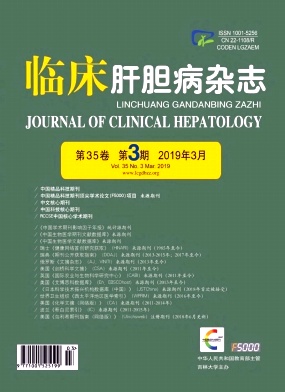|
[1] XU XD, DAI JJ, QIAN JQ, et al. Prevention of pancreatitis afterpapillary balloon dilatation by nasobiliary drainage:A randomizedcontrolled trial[J]. Dig Dis Sci, 2015, 60 (4) :1087-1091.
|
|
[2] XU G. Clinical effect of biliary metal stent implantation via en-doscopic retrograde cholangiopancreatography in treatment ofunresectable malignant extrahepatic biliary obstruction[J]. JClin Hepatol, 2018, 34 (2) :337-340. (in Chinese) 徐刚.经内镜逆行胰胆管造影胆道金属支架置入治疗不可切除肝外胆道恶性梗阻的效果观察[J].临床肝胆病杂志, 2018, 34 (2) :337-340.
|
|
[3] MUKAI T, YASUDA I, NAKASHIMA M, et al. Metallic stentsare more efficacious than plastic stents in unresectable malig-nant hilar biliary strictures:A randomized controlled trial[J]. JHepatobiliary Pancreat Sci, 2013, 20 (2) :214-222.
|
|
[4] DOWSETT JF, VAIRA D, HATFIELD AR, et al. Endoscopic biliarytherapy using the combined percutaneous and endoscopic tech-nique[J]. Gastroenterology, 1989, 96 (4) :1180-1186.
|
|
[5] VIENNE A, HOBEIKA E, GOUYA H, et al. Prediction of drain-age effectiveness during endoscopic stenting of malignant hilarstrictures:The role of liver volume assessment[J]. Gastroint-est Endosc, 2010, 72 (4) :728-735.
|
|
[6] UPPAL DS, WANG AY. Advances in endoscopic retrogradecholangiopancreatography for the treatment of cholangiocarcino-ma[J]. World J Gastrointest Endosc, 2015, 7 (7) :675-687.
|
|
[7] KERDSIRICHAIRAT T, ARAIN MA, ATTAM R, et al. Endo-scopic drainage of> 50%of liver in malignant hilar biliary ob-struction using metallic or fenestrated plastic stents[J]. ClinTransl Gastroenterol, 2017, 8 (8) :e115.
|
|
[8] SAWAS T, AL HALABI S, PARSI MA, et al. Self-expandablemetal stents versus plastic stents for malignant biliary obstruc-tion:A meta-analysis[J]. Gastrointest Endosc, 2015, 82 (2) :256-267. e7.
|
|
[9] ALMADI MA, BARKUN A, MARTEL M. Plastic vs. self-ex-pandable metal stents for palliation in malignant biliary obstruc-tion:A series of meta-analyses[J]. Am J Gastroenterol, 2017, 112 (2) :260-273.
|
|
[10] MARTINEZ JM, ANENE A, BENTLEY TG, et al. Cost effec-tiveness of metal stents in relieving obstructive jaundice in pa-tients with pancreatic cancer[J]. J Gastrointest Cancer, 2017, 48 (1) :58-65.
|
|
[11] RERKNIMITR R, ANGSUWATCHARAKON P, RATANACHU-EKT, et al. Asia-Pacific consensus recommendations for endo-scopic and interventional management of hilar cholangiocarcino-ma[J]. J Gastroenterol Hepatol, 2013, 28 (4) :593-607.
|
|
[12] TANGUTURI SK, WO JY, ZHU AX, et al. Radiation therapy forliver tumors:Ready for inclusion in guidelines?[J]. Oncolo-gist, 2014, 19 (8) :868-879.
|
|
[13] HAN K, KO HK, KIM KW, et al. Radiofrequency ablation inthe treatment of unresectable intrahepatic cholangiocarcino-ma:Systematic review and meta-analysis[J]. J Vasc IntervRadiol, 2015, 26 (7) :943-948.
|
|
[14] STEEL AW, POSTGATE AJ, KHORSANDI S, et al. Endoscop-ically applied radiofrequency ablation appears to be safe in thetreatment of malignant biliary obstruction[J]. Gastrointest En-dosc, 2011, 73 (1) :149-153.
|
|
[15] SOFI AA, KHAN MA, DAS A, et al. Radiofrequency ablationcombined with biliary stent placement versus stent placement a-lone for malignant biliary strictures:A systematic review and meta-analysis[J]. Gastrointest Endosc, 2018, 87 (4) :944-951.
|
|
[16] YANG J, WANG J, ZHOU H, et al. Efficacy and safety of en-doscopic radiofrequency ablation for unresectable extrahepaticcholangiocarcinoma:A randomized trial[J]. Endoscopy, 2018, 50 (8) :751-760.
|
|
[17] HAN SY, SONG GA, KIM DU, et al. Bile duct patency main-tained after intraductal radiofrequency ablation in a case ofhepatocellular cholangiocarcinoma with bile duct invasion[J].Clin Endosc, 2018, 51 (2) :201-205.
|
|
[18] CAMUS M, NAPOLEON B, VIENNE A, et al. Efficacy and safetyof endobiliary radiofrequency ablation for the eradication of resid-ual neoplasia after endoscopic papillectomy:A multicenter pro-spective study[J]. Gastrointest Endosc, 2018, 88 (3) :511-518.
|
|
[19] ZHOU C, WEI B, GAO K, et al. Biliary tract perforation follow-ing percutaneous endobiliary radiofrequency ablation:A reportof two cases[J]. Oncol Lett, 2016, 11 (6) :3813-3816.
|
|
[20] CHEN Y, WANG XL, YAN ZP, et al. HDR-192Ir intraluminalbrachytherapy in treatment of malignant obstructive jaundice[J]. World J Gastroenterol, 2004, 10 (23) :3506-3510.
|
|
[21] VALEK V, KYSELA P, KALA Z, et al. Brachytherapy and per-cutaneous stenting in the treatment of cholangiocarcinoma:Aprospective randomised study[J]. Eur J Radiol, 2007, 62 (2) :175-179.
|
|
[22] YOSHIOKA Y, OGAWA K, OIKAWA H, et al. Impact of in-traluminal brachytherapy on survival outcome for radiation ther-apy for unresectable biliary tract cancer:A propensity-scorematched-pair analysis[J]. Int J Radiat Oncol Biol Phys, 2014, 89 (4) :822-829.
|
|
[23] XU X, LI J, WU J, et al. A systematic review and meta-anal-ysis of intraluminal brachytherapy versus stent alone in thetreatment of malignant obstructive jaundice[J]. CardiovascIntervent Radiol, 2018, 41 (2) :206-217.
|
|
[24] LI S, HE X, DANG L, et al. Efficacy of (125) I versus non- (125) I combined with transcatheter arterial chemoembolization for thetreatment of unresectable hepatocellular carcinoma with obstruc-tive jaundice[J]. Dig Dis Sci, 2018, 63 (2) :321-328.
|
|
[25] ZHU HD, GUO JH, HUANG M, et al. Irradiation stents vs. con-ventional metal stents for unresectable malignant biliary obstruc-tion:A multicenter trial[J]. J Hepatol, 2018, 68 (5) :970-977.
|
|
[26] YANG J, SHEN H, JIN H, et al. Treatment of unresectable ex-trahepatic cholangiocarcinoma using hematoporphyrin photo-dynamic therapy:A prospective study[J]. PhotodiagnosisPhotodyn Ther, 2016, 16:110-118.
|
|
[27] DOLAK W, SCHWAIGHOFER H, HELLMICH B, et al. Photo-dynamic therapy with polyhematoporphyrin for malignant biliaryobstruction:A nationwide retrospective study of 150 consecu-tive applications[J]. United European Gastroenterol J, 2017, 5 (1) :104-110.
|
|
[28] MOOLE H, TATHIREDDY H, DHARMAPURI S, et al. Success ofphotodynamic therapy in palliating patients with nonresectablecholangiocarcinoma:A systematic review and meta-analysis[J]. World J Gastroenterol, 2017, 23 (7) :1278-1288.
|
|
[29] SHIM CS, CHEON YK, CHA SW, et al. Prospective study ofthe effectiveness of percutaneous transhepatic photodynamictherapy for advanced bile duct cancer and the role of intraduc-tal ultrasonography in response assessment[J]. Endoscopy, 2005, 37 (5) :425-433.
|
|
[30] WAGNER A, WIEDMANN M, TANNAPFEL A, et al. Neoadju-vant down-sizing of hilar cholangiocarcinoma with photody-namic therapy-long-term outcome of a phase II pilot study[J]. Int J Mol Sci, 2015, 16 (11) :26619-26628.
|
|
[31] STRAND DS, COSGROVE ND, PATRIE JT, et al. ERCP-di-rected radiofrequency ablation and photodynamic therapy areassociated with comparable survival in the treatment of unre-sectable cholangiocarcinoma[J]. Gastrointest Endosc, 2014, 80 (5) :794-804.
|
|
[32] WENTRUP R, WINKELMANN N, MITROSHKIN A, et al. Pho-todynamic therapy plus chemotherapy compared with photo-dynamic therapy alone in hilar nonresectable cholangiocarcino-ma[J]. Gut Liver, 2016, 10 (3) :470-475.
|







 DownLoad:
DownLoad: